Devotion [Part 1/2] [Please Don't Tag As Ship :)]
![Devotion [Part 1/2] [Please Don't Tag As Ship :)]](https://64.media.tumblr.com/83de38034685d0fa8b096f33e346ec3e/e35bc1666be06c6d-06/s500x750/707dab29825d18cf9652cb9fc20a40ff5eb4e949.png)
Devotion [Part 1/2] [Please don't tag as ship :)]
More Posts from Ardouradvice and Others
Writing a Blind or Visually Impaired Character
A Multi-Step Guide Written by a Visually Impaired Writer and Blogger
I’m hoping this blog will over time develop its own following, and when it does people will inevitably see my bio and notice what I included: I’m visually impaired.
Yes, a visually impaired writer, and I’ve written with two blind characters before so I have some practice in the field.
So, inevitably, someone is going to ask how to write a blind character.
Or, at least, I hope you’ll ask someone who’s actually blind or visually impaired about writing a blind character before you get too involved with your new WIP.
All parts will be tagged #blindcharacter in my blog, and I will add links to every post as I finish each part. Follow my blog for more writing advice.
Note, this post updates fairly often and old versions are still floating around out there. The most current version of this post is pinned to my blog with any new guides or links you might of missed.
As of 24 January 2021, this is the most extensive and screen reader friendly version of this post.
Part One: Crafting the Blind Character
In which I tell you how to begin making a blind character who is more than a cardboard cutout
Part Two: Narrative Choice, Visual Description, Verbal Description, Social Interaction
In which I give you a basic rundown on how to write from the perspective of a character who can’t see and still make the narration descriptive
Part Three: Tropes and Clichés to Avoid
Your blind readers will thank you for not being the 5000th person to do this and manage to actually finish your story. (Do you have any idea how many stories I’ve noped out of within two chapters because of these clichés? A Lot.)
-New- Part Four: Canes, Guide Dogs, and O&M
Everything I can tell you about 1) how to learn how to use a cane 2) how a cane works 3) how to describe what your character experiences with their cane 4) everything I know on guide dogs
Part Five: Small Aspects of being Blind You Never Thought Of
5 January 2021 Edit: This link has been fixed to correspond with the correct post
Or, really, very normal everyday things for blind people, the inclusion of which will make your characters more real and authentic. It’s the tiny details.
Part Six: Should You Cure Your Character’s Blindness? (Short Answer: No)
There’s no way to write a cure for your blind character that doesn’t make blind readers hate you. Sorry. We came here to finally experience a relatable character who experiences the world like us, but none of us are getting cured so seeing this character we learned to love become something alien from us in the end feels like a slap in the face
Why I’m Blind and What I See -NEW-
I thought I’d finally make a post explaining the complicated situation about my vision. Includes an explanation of visual snow and exotropia, two of the three causes for my vision issues.
Writing Blind Characters Falling in Love, an Advice Post:
Someone asked what being blind and falling in love have to do with each other. Honestly, blindness changes your perspective on everything and it makes an impact on every relationship you have. This includes some things that you definitely do not want your character’s love interest to be/do.
Writing Blind Jokes (Should You Do It?)
You know those flow charts of “should you do x?” going around? It’s like that, but screen reader friendly. Should you write blind jokes. It’s pretty complicated and there are a lot of possible scenarios and details to consider.
Advice for Writing Toph Beifong -NEW-
In this I discuss what I would like to see done in fanfiction with Toph’s character after ten years of reading Avatar the Last Airbender fanfiction
A small essay addressing the frequently asked question on giving your blind character a superpower to help them “see.”
It’s became a popular question, so to make the answer easier/faster for everyone to access, I wrote what will usually be my initial answer. Below there are a few links to some notable past questions on this subject.
Mourning My Vision, it’s More than Depression.
A small personal essay addressing the nuances of the mourning period you experience with a new disability. The mourning period is mentioned in other guides, but this is more detailed.
Dealing with Heightened Senses, a video by Molly Burke with additional commentary by me
While Molly talks about the myths and truths about heightened senses, I talk about the correlation with blindness and neuro-divergency and how co-morbid disorders/disabilities might affect sensory processing.
Satirical Commentary on the phrase “that blank look in their eyes” used too often in fiction to identify a blind character
a:tla, I’m looking at you (and my eyes aren’t blank)
I Found a Lost Piece of Blindness History
My grandmother told me about her blind aunt and how she sent letters. It led me to speculate about all the O&M things people develop on their own but never get a chance to pass onto other blind people. Technology and techniques are lost in history and reinvented, including the white cane ad guide dogs.
Includes a little history on the introduction of guide dogs into the 20th century
The Following are Answered Anon Questions
Making Your Blog More Accessible
Making Links Accessible to Screen Readers
Reblogging to Add an Image Description to Someone Else’s Image
Why I Write Image Descriptions
Writing Blind Characters
Advice for a Character Who was Born Blind
Over-Protective Parents of a Blind Character, Why They’re Over-Protective and How to Avoid Crossing a Line
A Blind Character in Victorian Era Historical Fiction
Is It Bad Not to Have Guide Dogs in a Fantasy/Historical Setting Without Guide Dogs (short answer: it’s not bad)
Someone Asked About My Thoughts on a Medusa-like Character Blinding Herself to Avoid Hurting Anyone
-New- Characters Who Have Recently Gone Blind and Avoiding Inspiration Porn
Talking about Popular Blind Characters In Media
Does Daredevil’s Echolocation Negate His Blindness
Someone Else was Asked How to Write Daredevil Fanfiction
Blind Characters with Superpowers/Fighting Styles
World Setting where the General Population has a Superpower
Superpowers that don’t involve sight, Five questions to ask yourself if this superpower is a bad idea or a good one
-New- Your character would not use a cane as a weapon, it’s a bad idea
D&D/Roleplaying Blind Characters
-New- Animal Familiars Acting as Service Animals and Advice for Communicating with Your DM
-New- Portraying Older Blind Characters + Causes for Vision Loss with Old Age
I want to start drawing landscape. Do you have any tips?
Took me a while to answer this (sorry anon)! Drawing landscapes for me are mostly just a matter of doing a few 'art studies' and a bit of imitating life. Here's a brief rundown of my process. I find that I learn best when I see a picture or a reference that really tickles my fancy, like these ones! First image for it's colors, and the second for it's composition.


And then I pull up the dreaded white canvas on start on a rough idea or just start dribbling out the basics: composition, a bit of color, general shapes, etc. If you have a hard time doing general landscapes, don't worry! Imagine breaking it down like this: You layer on some general colors and shapes; don't be afraid to make mistakes, you can always go back to it! Be loose and organic with it at first, we're not striving for detail yet, and just let that brush move freely. And once you got the shapes down, you can go back and forth in the canvas to start detailing. I find that it's best if you really look into how some things are "made". Like for example, how that patch of grass in your reference is made: 'is it layered? does it have some shiny bits in it that I wanna highlight? are the blades of grass sharp enough to individually detail or more clumped up together to just put in a sorta grassy blob?'. Also, don't be afraid to experiment a bit. Try putting some highlights around the edges to make it pop out more, or try putting small changes in the color you're working with; something that's close but still different, so that it compliments each other! Then it's just a matter of going forward with it; see what you like and what you wanna keep and imitate, see what you want to change or maybe just leave out on. Keep on detailing and going until you're happy with it!

This is a really brief rundown and explanation of a process that can be entire unique to each and everyone of us, and takes a bit of time and practice to pull off. But I believe in you! We all start from somewhere, sometime down the line; and that can start right now if you want it to! Goodluck to any artists out there who wanna try out landscapes. It's a fun and comforting process of organic and loose art that breathes in a lot of life in some people, especially me. Twitter | Prints | Ko-Fi | Patreon
Someone has probably already asked you this but do you have any tips on studying/understanding perspective? I keep trying to find resources to learn but none of them really stick or are actually useful
so I'm hoping that your issue isn't just figuring out the difference between 1-point, 2-point, and 3-point perspective and how it works, because there are tons and tons of resources available for that, and I'm guessing what people tend to get tripped up on is what you're supposed to be doing with your grid.
I'm definitely far from being an expert on understanding perspective, but I'll share some of the things that helped ME finally Get It.


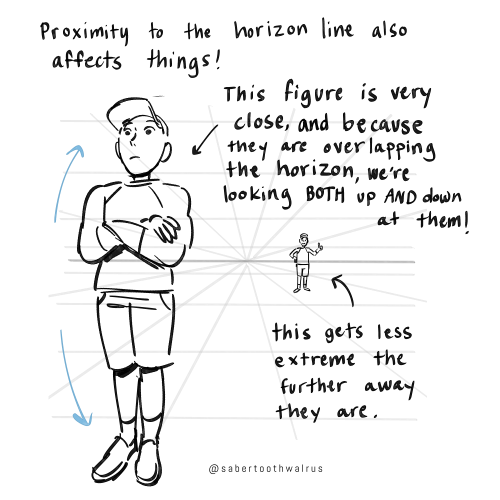
Things like eye level and different camera angles can be a GREAT tool to use when doing a comic or storyboard between multiple characters of different heights!! I actually drew an example of this exact thing for a friend about a month ago (I used adventure time characters bc they're easy to draw and have a good height variety):
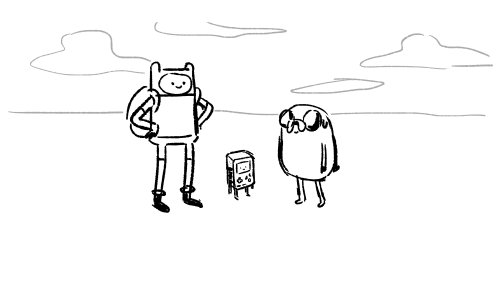
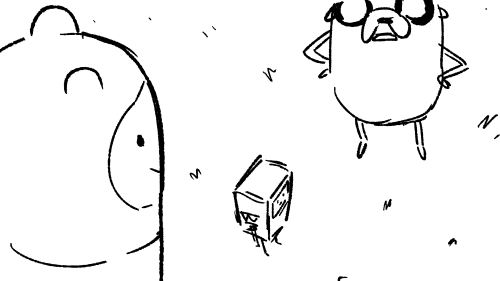


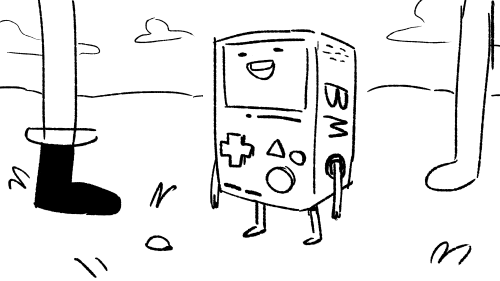
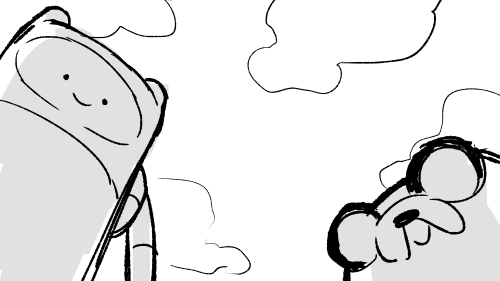
You can use camera angles like this to add variety to your shots, and even use it to help convey something emotional (using a down-shot on a character to show that they FEEL small, use an up-shot on a character to make them look more intimidating, etc etc)
hope this helps!
Dear downydig,
Any secret knowledge on how to do fluid and dynamic poses? (Btw, I love ur art!! So comfy and cozy!!!)
Sincerely, Paper-Starz
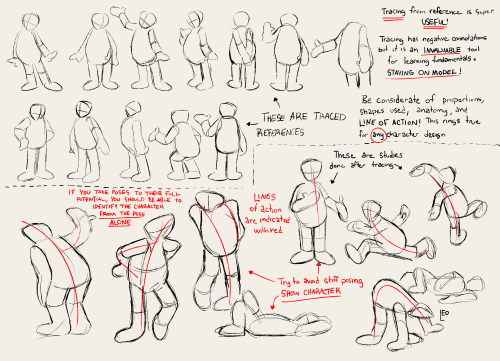
Hello hello! I have some advice! I did a thing on lines of action and the benefits of tracing in learning models a LONG time ago… the advice still holds up! Use shapes like ‘s’ curves, ‘c’ curves, and even sharper ‘U’s to give a fun fluid motion! Limbs and spine are the main help here, but the head sometimes comes into play ✌️
I have a little more to add, however! One of these pictures is my oc and the other is a king fu panda character but it’s still useful! When creating a pose, you can also use silhouette! Bonus points if the shape of the silhouette is different than the shapes that compose the character (in a way that matches the personality of course!)


So I thought this was commonly known internet navigation (but apparently it might just be those of us who have been using the internet since the 90’s who still know it). Or so it seems based on… a grumpy comment I got.
When you see an arrow like this:

It means you click it to expand out a hidden section.

It’s an accordion section/menu! It’s useful in web design to hide information that may be overwhelming under specific headers so people can only see what they need.
Here I’m using it for people who need the content warnings to be able to check, but for those who don’t need them and don’t want to be spoiled to just move right past without accidentally reading anything.
It’s still the user’s responsibility to click the arrow and read things as they need! But it is all warned. (And, yes, the all encompassing issues are already a tag on the fic, I’m just providing additonal warnings per chapter.)
Quick editing tip: Passing time
Hey all, here’s a quick tip about showing the passage of short amounts of time in a scene. I see a lot of beats like this:
She hesitated
He paused
A few seconds later
There was a long silence
He waited for her to answer
She didn’t respond
Instead of telling us there’s a brief moment of silence or pause in your scene, try showing us by creating the feeling that time has passed through action, description, or inner monologue. Here are a few examples.
Before:
“Are you coming or not?”
He waited for her to answer, but she didn’t respond.
“Clare? Did you hear me?”
“Huh?”
After:
“Are you coming or not?”
Clare scrolled through her phone, her face illuminating with a eerie blue glow.
“Clare? Did you hear me?”
“Huh?”
Before:
Jared lingered at the suspect’s front gate. If this guy didn’t answer Jared’s questions, he was screwed.
“Hey you!” a voice shouted. “Get off my property!”
Jared hesitated. Finally, he turned to face the man. “I’m afraid I can’t do that.”
After:
Jared lingered at the suspect’s front gate. If this guy didn’t answer Jared’s questions, he was screwed.
“Hey you!” a voice shouted. “Get off my property!”
Jared patted his holster. He had a gun, but he certainly didn’t want to use it. Taking a deep breath, he turned to face the man. “I’m afraid I can’t do that.”
Not only does creating a pause instead of describing a pause allow your reader to feel the moment more vividly, it gives you a chance to explain what exactly that pause is about. People hesitate, pause, don’t respond, etc. for all kinds of reasons. Give us as much insight as you can into your weird quiet moment.
Of course, you don’t need to do this every single time. Sometimes it’s fine to say “he paused” or “the room was quiet for a moment”—it could be the best choice for that scene. But look back through your draft and see if you’ve used those “telling” descriptions more often than you needed to. If so, try to create the feeling of a pause—perhaps one that gives the reader a bit more information—using these techniques.
Hope this helps!
hey i hope its okay to ask but i was wondering what your process for art looks like? you have a really unique style thats like. somewhat eyestrainy but still soft looking and i'm just curious because it is very tasty
Got super long winded so check under cut :]
also this is for my more.. recent art? for more of my older stuff I made THIS a while back <- the prev thing also has a lot more actual discussion on the Whys of color choices and the like. More informative? I actually cared a lot more about making things look nice back than HAHA



Sometimes I will stop here [most of the time actually [or a bit before [forgoing colored lines]]]





And again, liable to stop at Any of these points. [exept Only flat colors that looks boring as hell HAHA]
Finished product VVV


Whipped this up real quick to show my palette basics. Here’s my coloring tutorial post: https://kandyarts.tumblr.com/post/628614256321036288/yalright-punks-i-made-a-fun-lil-coloring-tutorial

writing tips - fevers
guys so the injury post absolutely fucking exploded (500 notes in 24 hours is a lot for me) and the fever part really threw yall for a loop.
I didn't go into it but I can! just to clear up questions.
Fevers are funky asf
like, there are so many factors that indicate when a fever is like a big deal and when it's not. part of it has to do with the age of the patient, how long the fever lasts, any causes or prexisting conditions....
Like this:
If person is feverish due to an infection, their symptoms are gonna be slightly different than someone who is fighting the flu. this is because the antibodies are attacking different parts of the nervous system with different kinds of chemicals blah de blah blah blah.
The younger the patient, the more susceptible they are. if the character is a child, a fever of 102 F is way worse than a 30 year old man experiencing that. It'll take a larger toll on the baby's body.
Some people have naturally higher body temps. There is a standard deviation away from the target temp that is still ok. Some people simply exist at 99.2 F, even though for some that's febrile.
idk man it's weird people are weird don't @ me about it.
obviously it's bio science which means not everything has exactly a clear answer. there are so mnay variables at play that it's easier just to blanket statement the whole thing.
because this isn't a blog for medical advice.
please don't use this blog for medical advice.
100% of death.
thanks guys love the effort
xox
-
 agarsett liked this · 4 weeks ago
agarsett liked this · 4 weeks ago -
 finleyforevermore liked this · 2 months ago
finleyforevermore liked this · 2 months ago -
 goldenageofwireless reblogged this · 2 months ago
goldenageofwireless reblogged this · 2 months ago -
 soul-the-gay liked this · 2 months ago
soul-the-gay liked this · 2 months ago -
 peachphernalia reblogged this · 2 months ago
peachphernalia reblogged this · 2 months ago -
 mxlgnxnt liked this · 2 months ago
mxlgnxnt liked this · 2 months ago -
 mangothefool liked this · 2 months ago
mangothefool liked this · 2 months ago -
 ghost--buzzard reblogged this · 2 months ago
ghost--buzzard reblogged this · 2 months ago -
 ghost--buzzard liked this · 2 months ago
ghost--buzzard liked this · 2 months ago -
 lovelypink2005 liked this · 2 months ago
lovelypink2005 liked this · 2 months ago -
 kay-afandomcollector11 liked this · 3 months ago
kay-afandomcollector11 liked this · 3 months ago -
 lionacuty liked this · 3 months ago
lionacuty liked this · 3 months ago -
 gracebeth3604 reblogged this · 3 months ago
gracebeth3604 reblogged this · 3 months ago -
 spindizc-io liked this · 4 months ago
spindizc-io liked this · 4 months ago -
 05harmonia liked this · 4 months ago
05harmonia liked this · 4 months ago -
 ardouradvice reblogged this · 4 months ago
ardouradvice reblogged this · 4 months ago -
 sploon-fic-fan reblogged this · 4 months ago
sploon-fic-fan reblogged this · 4 months ago -
 trigonegok liked this · 5 months ago
trigonegok liked this · 5 months ago -
 chocolateboxheart liked this · 5 months ago
chocolateboxheart liked this · 5 months ago -
 kris-chr liked this · 5 months ago
kris-chr liked this · 5 months ago -
 m1lkt00th reblogged this · 5 months ago
m1lkt00th reblogged this · 5 months ago -
 reinagony reblogged this · 5 months ago
reinagony reblogged this · 5 months ago -
 reinagony liked this · 5 months ago
reinagony liked this · 5 months ago -
 leafgorge reblogged this · 5 months ago
leafgorge reblogged this · 5 months ago -
 leafgorge liked this · 5 months ago
leafgorge liked this · 5 months ago -
 allegedtomfoolery liked this · 5 months ago
allegedtomfoolery liked this · 5 months ago -
 halfling-myth-lady liked this · 5 months ago
halfling-myth-lady liked this · 5 months ago -
 letardoursprout reblogged this · 5 months ago
letardoursprout reblogged this · 5 months ago -
 letardoursprout reblogged this · 5 months ago
letardoursprout reblogged this · 5 months ago -
 letardoursprout liked this · 5 months ago
letardoursprout liked this · 5 months ago -
 exasperated-neophyte liked this · 5 months ago
exasperated-neophyte liked this · 5 months ago -
 m1lkt00th liked this · 6 months ago
m1lkt00th liked this · 6 months ago -
 byeclownguy liked this · 6 months ago
byeclownguy liked this · 6 months ago -
 purplekittybanan liked this · 6 months ago
purplekittybanan liked this · 6 months ago -
 sunnydayaoe reblogged this · 6 months ago
sunnydayaoe reblogged this · 6 months ago -
 the-tomcat-disposable reblogged this · 6 months ago
the-tomcat-disposable reblogged this · 6 months ago -
 the-tomcat-disposable reblogged this · 6 months ago
the-tomcat-disposable reblogged this · 6 months ago -
 the-tomcat-disposable reblogged this · 6 months ago
the-tomcat-disposable reblogged this · 6 months ago -
 the-tomcat-disposable reblogged this · 6 months ago
the-tomcat-disposable reblogged this · 6 months ago -
 ghosttai liked this · 6 months ago
ghosttai liked this · 6 months ago -
 goosehasapencil liked this · 6 months ago
goosehasapencil liked this · 6 months ago -
 adhd-fandom-and-gay reblogged this · 6 months ago
adhd-fandom-and-gay reblogged this · 6 months ago -
 adhd-fandom-and-gay liked this · 6 months ago
adhd-fandom-and-gay liked this · 6 months ago -
 tiredjaybird liked this · 6 months ago
tiredjaybird liked this · 6 months ago -
 spellboundcities liked this · 6 months ago
spellboundcities liked this · 6 months ago -
 goobbiestgoober liked this · 6 months ago
goobbiestgoober liked this · 6 months ago -
 sani-ra liked this · 6 months ago
sani-ra liked this · 6 months ago -
 artist-ea liked this · 6 months ago
artist-ea liked this · 6 months ago -
 heccnahfam liked this · 6 months ago
heccnahfam liked this · 6 months ago

sideblog for @letardoursprout so i have somewhere to collect all the tutorials/advice that i likeicon by lovelyshiz. header by hexh-pixel
66 posts
